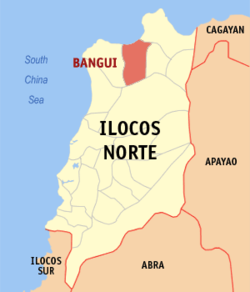Bangui
Bangui | |
|---|---|
Municipality | |
 | |
 Mapa de Ilocos Norte con Bangui resaltado | |
| Coordinates: 18°32'16"N, 120°45'55"E | |
| Nación | Filipinas |
| Región | Región de Ilocos (Región I) |
| Provincia | Ilocos Norte |
| Número de barangay | 14 |
| Fundación | 1786 |
| Gobierno | |
| • Type | Sangguniang Bayan |
| • Electorado | 11 414 votantes (9 Mayo 2022) |
| Area | |
• Total | 112,98 kilómetro cuadrado km2 (Formatting error: invalid input when rounding sq mi) |
| Elevation | 88 metro m (Bad rounding hereFormatting error: invalid input when rounding ft) |
| Population (1 Mayo 2020) | |
• Total | 15 019 |
| • Hogares | 4025 |
| Economía | |
| • Clase de ingresos | es un aca cuatro clase de municipalidad |
| • Incidencia de la pobreza | 6,08 |
| • Ingresos | ₱ 204,4 million (2022) |
| • Activos | ₱ 538,2 million (2022) |
| • Pasivos | ₱ 111,4 million (2022) |
| • Gastos | ₱ 145,7 million (2022) |
| Time zone | UTC+8 (PST) |
| Código postal | 2920 |
| PSGC | |
| Código telefonico | 77 |
| Clima | clima monzónico |
| Lenguaje nativo | ilocano Tagalog |
| Website | http://www.bangui.gov.ph/ |
Bangui es un aca cuatro clase de municipalidad na provincia de Ilocos Norte, [[Filipinas]]. Tiene este zona de 112.98 kilómetro cuadrado kilometro cuadrado. Comporme del 1 Mayo 2020 censo este tiene papulidad de 15,019 personas y 4,025 hogares. El designada codigo postal 2920 y PSGC 012804000.
Barangay
- Abaca
- Bacsil
- Banban
- Baruyen
- Dadaor
- Lanao
- Malasin
- Manayon
- Masikil
- Nagbalagan
- Payac
- San Lorenzo (Pob.)
- Taguiporo
- Utol
Demografía
| Año | Populación | ±% p.a. |
|---|---|---|
| 1903 | 8215 | — |
| 1918 | 11 152 | +2.06% |
| 1939 | 13 325 | +0.85% |
| 1948 | 14 126 | +0.65% |
| 1960 | 9026 | −3.66% |
| 1970 | 11 053 | +2.04% |
| 1975 | 11 480 | +0.76% |
| 1980 | 11 122 | −0.63% |
| 1990 | 12 921 | +1.51% |
| 1995 | 13 774 | +1.21% |
| 2000 | 14 327 | +0.85% |
| 2007 | 14 634 | +0.29% |
| 2010 | 15 025 | +0.96% |
| 2015 | 14 672 | −0.45% |
| 2020 | 15 019 | +0.46% |
| Ref: Autoridad de Estadísticas de Filipinas[3][4][5][6] | ||
Referencias
- ↑
"Province: Ilocos Norte". PSGC Interactive. Quezon City, Philippines: Philippine Statistics Authority. Retrieved Diciembre 17, 2016.
{cite web}: Check date values in:|accessdate=(help) - ↑ "PSA Releases the 2021 City and Municipal Level Poverty Estimates". Autoridad de Estadística de Filipinas. 2 Abril 2024. Retrieved 28 Abril 2024.
- ↑
Census of Population (2015). "Region I (Ilocos Region)". Total Population by Province, City, Municipality and Barangay. Philippine Statistics Authority.
{cite encyclopedia}: External link in|chapterurl=|chapterurl=ignored (|chapter-url=suggested) (help)CS1 maint: numeric names: authors list (link) - ↑
Census of Population and Housing (2010). "Region I (Ilocos Region)". Total Population by Province, City, Municipality and Barangay. NSO.
{cite encyclopedia}: External link in|chapterurl=|chapterurl=ignored (|chapter-url=suggested) (help)CS1 maint: numeric names: authors list (link) - ↑
Censuses of Population (1903–2007). "Region I (Ilocos Region)". Table 1. Population Enumerated in Various Censuses by Province/Highly Urbanized City: 1903 to 2007. NSO.
{cite encyclopedia}: External link in|chapterurl=|chapterurl=ignored (|chapter-url=suggested) (help)CS1 maint: numeric names: authors list (link) CS1 maint: url-status (link) - ↑
"Province of Ilocos Norte". Municipality Population Data. Local Water Utilities Administration Research Division. Retrieved Diciembre 17, 2016.
{cite web}: Check date values in:|accessdate=(help)